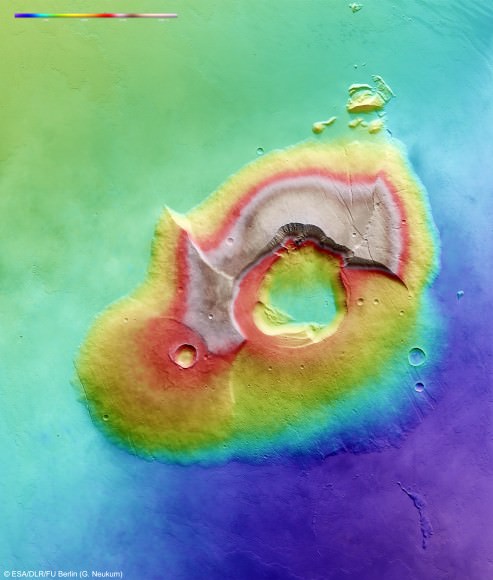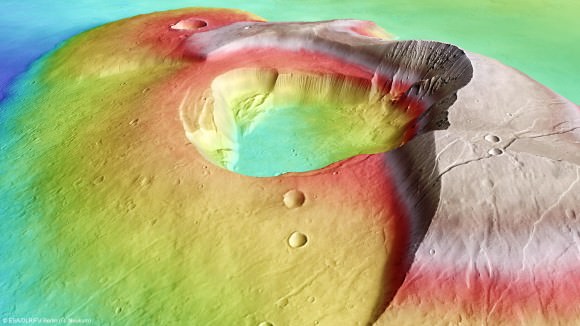
Tharsis Tholus towers 8 km above the surrounding terrain. The base stretches 155 x 125 km. What makes Tharsis Tholus unusual is its extremely battered condition.
Image Credit: ESA/DLR/FU Berlin (G. Neukum)
Image Credit: ESA/DLR/FU Berlin (G. Neukum)
Earlier this week, The European Space Agency released new Mars images taken by instruments aboard the Mars Express spacecraft. The images show details of Tharsis Tholus, which appears to be a very large and extinct volcano that has been battered and deformed over time.
On Earth, Tharsis Tholus would be a towering giant of a volcano, looming 8 km above the surrounding terrain, with a base of roughly 155 x 125 km. Despite its size, Tharsis Tholus is just an average run-of-the-mill volcano on Mars. That being said, it isn’t the size of Tharsis Tholus that makes it interesting to scientists – what makes the remnants of this volcano stand out is its extremely battered condition.
What does the battered condition of Tharsis Tholus mean to planetary scientists studying Mars?
Details shown in the image above by the HRSC high-resolution stereo camera on ESA’s Mars Express spacecraft reveal signs of dramatic events which have significantly altered the volcanic region of Tharsis Tholus. Two (or more) large sections have collapsed around its eastern and western regions in the past several billion years, leaving signs of erosion and faulting.
Details shown in the image above by the HRSC high-resolution stereo camera on ESA’s Mars Express spacecraft reveal signs of dramatic events which have significantly altered the volcanic region of Tharsis Tholus. Two (or more) large sections have collapsed around its eastern and western regions in the past several billion years, leaving signs of erosion and faulting.
One main feature of Tharsis Tholus that stands out is the volcanic caldera in its center. The caldera is nearly circular, roughly 30 km across and ringed by faults that have allowed the floor of the caldera to subside by nearly 3km. Planetary scientists believe the volcano emptied its magma chamber during eruptions. Once the magma chamber had emptied its lava onto the surface, the chamber roof became unstable under its own weight and collapsed, forming the large caldera.

This image was created using a Digital Terrain Model (DTM) obtained from the High Resolution Stereo Camera on ESA’s Mars Express spacecraft. Elevation data from the DTM is colour coded: purple indicates the lowest lying regions and beige the highest. Image Credit: ESA/DLR/FU Berlin (G. Neukum)
This month is a very busy month for Mars exploration. Russia’s recently launched (and in distress) Phobos mission (Mission coverage at:http://www.universetoday.com/90808/russians-race-against-time-to-save-ambitious-phobos-grunt-mars-probe-from-earthly-demise/) has a mission goal of returning a sample from Mars’ moon, Phobos, along with “piggyback” missions by China and the Planetary Society.
NASA’s plans to launch the Mars Science Laboratory on November 25th (Coverage at:http://www.universetoday.com/90639/curiosity-rover-bolted-to-atlas-rocket-in-search-of-martian-microbial-habitats/). MSL consists of the “Curiosity” rover and will be performing experiments designed to detect organic molecules, which may help detect signs of past or present life on Mars.
This month also marks the end of the “Mars500″ mission, which ended on Friday (coverage at: http://www.universetoday.com/90554/mars500-crew-ready-to-open-hatch/ when the participants opened their hatch for the first time since June 2010. During the past 520 days, the participants were working in a simulated spacecraft environment in Moscow.
Learn more about Mars Express at: http://www.esa.int/esaMI/Mars_Express/index.html
Source: Universe Today
No hay comentarios:
Publicar un comentario